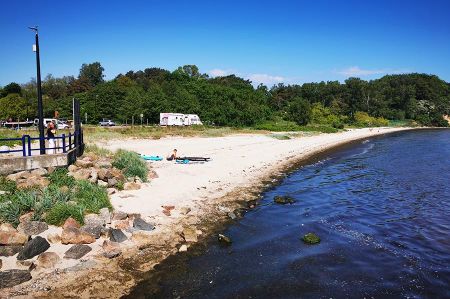Osłonino – formerly a fishing and landing place for Kashubians
- Written by Portal Editor
We've already been to Poland a few times and were mostly looking for accommodation in Gdynia that would allow a short trip to the centre and to see relatives living there.
It wasn't just the street noise that made us look for alternative accommodation - we ultimately came across the small town of Osłonino, about six kilometres southeast of the city of Puck and about 17 kilometres north of Gdynia, right on the Gdańsk river Located in a bay that offers very shallow, sandy beaches and therefore very shallow water.
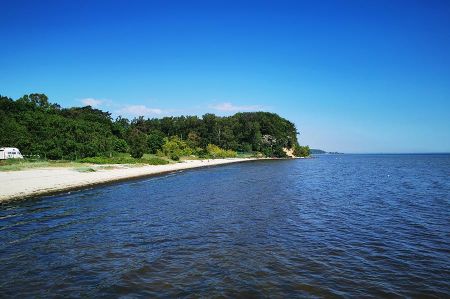 Ideal for small children, but (still almost) without any tourism, only two campers who were fishermen were present.
Ideal for small children, but (still almost) without any tourism, only two campers who were fishermen were present.
Here we booked a room with breakfast, which turned out to be a real stroke of luck.
Not only because the path to the beach is short and the facilities are perfect for self-catering, the staff was extremely helpful and friendly and the facility was very well maintained.
But it was also clear that our first route led to the beach.
On the eventful history of the town of Osłonino
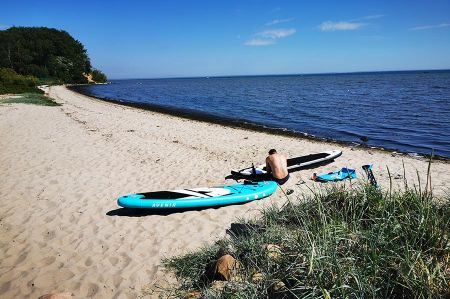 The town of Osłonino is located in the Pomerania and Kashubia region, in the southwest of the rural community on the Zatoka Pucka (Putziger Wiek). There is a small section of cliff that is up to 18 meters high.
The town of Osłonino is located in the Pomerania and Kashubia region, in the southwest of the rural community on the Zatoka Pucka (Putziger Wiek). There is a small section of cliff that is up to 18 meters high.
The place borders on the Beka nature reserve with the mouth of the Reda River (Rheda). The area is part of the Nadmorski Park Krajobrazowy (Coastal Landscape Park).
With the First Partition of Poland, the region came to the Kingdom of Prussia. From 1887 to 1919 the place belonged to the Putzig district in the West Prussia province of the German Empire. It had the status of a rural community in the Rutzau district.
After the end of the First World War, the district area including Osłonino was ceded to Poland based on the provisions of the Treaty of Versailles, effective January 20, 1920.
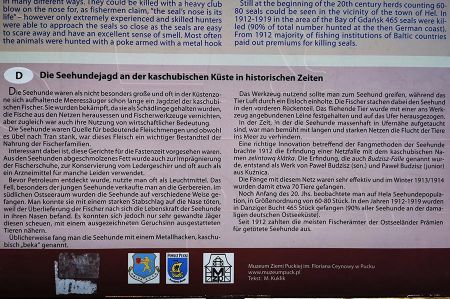 As part of the Polish Corridor, the area belonged to Pucki County and was incorporated into Morski County on January 1, 1927. As a result of the attack on Poland in 1939, the area of the corridor became part of the Reich territory in violation of international law and was assigned to the Reichsgau Danzig-West Prussia.
As part of the Polish Corridor, the area belonged to Pucki County and was incorporated into Morski County on January 1, 1927. As a result of the attack on Poland in 1939, the area of the corridor became part of the Reich territory in violation of international law and was assigned to the Reichsgau Danzig-West Prussia.
Oslanin was renamed Truchsassen in June 1942.
Towards the end of the Second World War in the spring of 1945, the Red Army occupied the district and handed it over to the People's Republic of Poland.
The German minority was expelled. In the years 1975–1998 the village belonged administratively to the Gdańsk Voivodeship; the Pucki County was dissolved during this period.
Osłonino - Still strongly connected to fishing
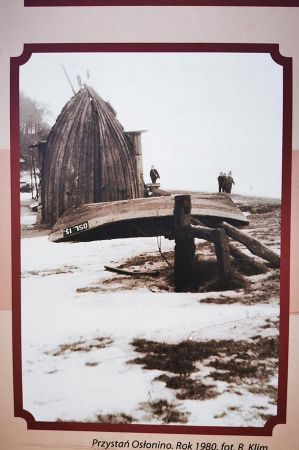 Our first walk to the bay left us a little surprised at the relatively large parking areas, which now seemed oversized for the size of the town without any parked vehicles.
Our first walk to the bay left us a little surprised at the relatively large parking areas, which now seemed oversized for the size of the town without any parked vehicles.
The solution only came the next day, because early in the morning there were a number of cars with boat trailers on site that launched their small boats and then parked on the site, which quickly became full.
When asked about the effort put into fishing, one of the fishermen explained that due to nature conservation, the boats have to be taken out again and again.
There is a constant coming and going with a great willingness to help each other, as we have observed several times.
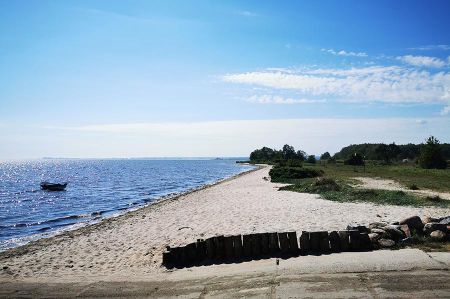 We were also amazed at the already completed cycle path, which is supposed to extend through the entire nature park; we had already mentioned the cycle path network in our article about the holiday resort of Rewa. We had already seen cyclists far away from the roads several times as we arrived.
We were also amazed at the already completed cycle path, which is supposed to extend through the entire nature park; we had already mentioned the cycle path network in our article about the holiday resort of Rewa. We had already seen cyclists far away from the roads several times as we arrived.
On the shore, some signs point out the fishing methods of the Kashubians, who have lived here for centuries. In particular, their methods of fishing, in turn those of seal catching, are described. We were particularly surprised by the last sentence: Since 1912, most of the fishing authorities in the Baltic Sea countries have been paying out premiums for killed seals. We'll ask if that's still the case today.
Please read as well:
Goslar - old town with narrow streets and half-timbered houses
Fort Saint-Jean – imposing city fortifications at the harbour
-
 Osłonino – former fishermen village
Osłonino – former fishermen village
Osłonino – former fishermen village
Osłonino – former fishermen village
-
 Osłonino – former fishermen village
Osłonino – former fishermen village
Osłonino – former fishermen village
Osłonino – former fishermen village
-
 Osłonino – former fishermen village
Osłonino – former fishermen village
Osłonino – former fishermen village
Osłonino – former fishermen village
-
 Osłonino – former fishermen village
Osłonino – former fishermen village
Osłonino – former fishermen village
Osłonino – former fishermen village
-
 Osłonino – former fishermen village
Osłonino – former fishermen village
Osłonino – former fishermen village
Osłonino – former fishermen village
-
 Osłonino – former fishermen village
Osłonino – former fishermen village
Osłonino – former fishermen village
Osłonino – former fishermen village
-
 Osłonino – former fishermen village
Osłonino – former fishermen village
Osłonino – former fishermen village
Osłonino – former fishermen village
-
 Osłonino – former fishermen village
Osłonino – former fishermen village
Osłonino – former fishermen village
Osłonino – former fishermen village
-
 Osłonino – former fishermen village
Osłonino – former fishermen village
Osłonino – former fishermen village
Osłonino – former fishermen village
https://www.alaturka.info/en/poland/gdansk/6640-oslonino-formerly-a-fishing-and-landing-place-for-kashubians#sigProId831573ffca
